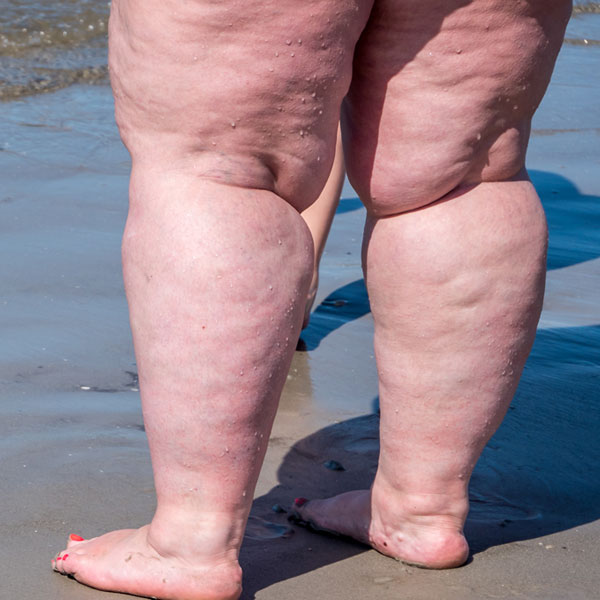What is Lipedema?
 Lipedema is a chronic condition that primarily affects women causing an enlargement of fat cells in the legs and arms and occasionally in the buttocks and abdomen. Despite being recognized for over 70 years, lipedema is still often confused with obesity. If left untreated, patients can suffer from a variety of health related issues that not only affect mobility but vital bodily functions as well. Terms such as “cankles” for ankles, and “stove pipes” for legs describe the appearance of Lipedema. Early treatment is critical in preventing increasing fat accumulations from being deposited with each passing year. Treatment in later stages is aimed at treating the swelling associated with this condition, decreasing pain and discomfort in the legs and preserving tissue health.
Lipedema is a chronic condition that primarily affects women causing an enlargement of fat cells in the legs and arms and occasionally in the buttocks and abdomen. Despite being recognized for over 70 years, lipedema is still often confused with obesity. If left untreated, patients can suffer from a variety of health related issues that not only affect mobility but vital bodily functions as well. Terms such as “cankles” for ankles, and “stove pipes” for legs describe the appearance of Lipedema. Early treatment is critical in preventing increasing fat accumulations from being deposited with each passing year. Treatment in later stages is aimed at treating the swelling associated with this condition, decreasing pain and discomfort in the legs and preserving tissue health.
Marcia V. Byrd, M.D. is the Medical Director of The Lipedema Surgery Center. The surgical aspect of treatment is lymph-sparing liposuction which utilizes specialized equipment and techniques. Dr. Byrd finds that the treatment of lipedema Is a natural extension of her many years of experience with various types of liposuction. It must be emphasized that lymph-sparing liposuction for the treatment of Lipedema is a medically necessary procedure and not cosmetic. For more information about The Lipedema Surgery Center click here.
What Causes Lipedema?
Doctors don’t yet know the exact cause of this fat disorder, but there is a hereditary component. Typically the women in a family may tend to carry their weight in their hips and thighs. Any major hormonal shift throughout different life stages can trigger or increase the effect of lipedema. Some examples of this would be puberty, which is a very common trigger and usually the first one. Another would be pregnancy, then menopause. All of these cause a change in hormonal balance, which is related to the onset of lipedema. It seems to occur in relation to estrogen levels, so this is why it affects women more than it does men.
- Heredity
- Hormonal changes (puberty, pregnancy, peri-menopause)
- Extreme stress
It is important to note that lipedema fat is not brought on by lifestyle choices, such as poor diet or lack of exercise.
Symptoms
In the first stage of lipedema, individuals may notice subtle changes in the appearance and feel of their legs and hips. The earliest signs of lipedema often include increased sensitivity to touch and pressure in the affected areas. This can lead to discomfort and tenderness when wearing tight clothing or undergoing physical activities that put pressure on the legs.
- Disproportionate body
- Expanded fat cells
- Blockage of of lymph fluid
- Painful fat
- Easy bruising
- No weight change with diet or exercise
- Cuff of fat at ankle and/or wrist
Stages and Types of Lipedema
Stage 1
lipedema is characterized by the presence of nodules or small fatty lumps beneath the skin. These nodules usually feel soft and spongy to the touch, and they may be accompanied by a feeling of heaviness or tightness in the legs. Some individuals may also experience mild pain or achiness in the affected areas, especially after prolonged periods of standing or walking.
In order to treat each patient’s unique physical condition, Dr. Marcia Byrd developed a system that categorizes the amount and location of fatty tissue. This system is a combination of staging and type identification to effectively treat lipedema. Learn more+
It is important to note that the distribution of fat in lipedema follows a distinct pattern. While the legs and hips are most commonly affected, the feet and hands remain unaffected. This asymmetrical distribution sets lipedema apart from other similar conditions.
Stage 2: Progression and noticeable changes
As lipedema progresses to stage 2, the symptoms become more pronounced and noticeable. In this stage, the affected areas become larger and disproportionate to the rest of the body. The nodules and fatty lumps beneath the skin continue to grow and may spread to additional areas, such as the arms.
Individuals with stage 2 lipedema may experience increased pain and discomfort, even with minimal pressure on the affected areas. This can make everyday tasks, like walking or standing, more challenging and painful. Swelling and fluid retention may also become more prevalent, leading to feelings of tightness and heaviness.
Stage 3:
In stage 3 of lipedema, the symptoms escalate, and the impact on daily life becomes significantly more challenging. At this stage, the affected areas continue to grow, causing a greater disproportion to the rest of the body. The nodules and fatty lumps become larger and more pronounced, making it difficult to ignore.
Individuals with stage 3 lipedema often experience severe pain and discomfort, even with minimal movement or pressure on the affected areas. Simple tasks like walking or standing may become nearly impossible due to the heaviness and constant pain. The swelling and fluid retention become more persistent and can lead to diminished mobility and further restriction.
Stage 4:
In the final stage of lipedema, stage 4, the condition reaches its most severe form, significantly impacting an individual’s daily life. At this stage, the affected areas have grown to an extreme extent, causing a profound disproportion to the rest of the body. The nodules and fatty lumps are not only larger but also become more hardened and fibrotic, further affecting mobility and overall comfort.
Individuals with stage 4 lipedema experience chronic pain and discomfort, often even at rest. The constant heaviness and swelling make it extremely challenging to engage in any physical activity, rendering simple tasks like walking or standing nearly impossible. Moreover, the skin in the affected areas may become more vulnerable to infections and ulcerations, adding to the already burdened condition.
Treatment
- Water-Jet Assisted Liposuction (WAL) and Power Assisted Liposuction (PAL) Learn more+
- Exercise to reduce fluid buildup and boost mobility.
- Stretch compression bandages to increase pressure in the swollen legs and reduce fluid buildup.
- Manual Lymphatic Drainage (MLD) to stimulate the flow of lymph fluid around blocked areas to healthy vessels, where it can drain into the venous system.
Dr. Marcia Byrd and her team of experts care for lipedema patients throughout the United States and Canada. If you suspect that you suffer from lipedema, call (770) 587-1711 and schedule a consultation. Be the best you can be and live a full life – there is no reason to wait!
